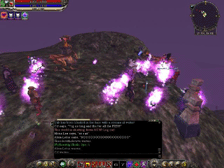

Who’s more honest: Politicians or scientists?
Normally I wouldn’t have to ask a stupid question like that, since the answer would be obvious. But the recent wars over evolution have created a sense in many parts of the American public that scientists are liars — venal elites who refuse to accept Intelligent Design arguments that supposedly disprove Darwinism. Indeed, some of our most prominent politicians — like Sam Brownback and Rick Santorum — are pushing this line, even as they advocate for legislation that would require science teachers to present blatantly unscientific speculation to students.
In this context, the recent debacle over Hwang Woo Suk did not help the cause of science. As you’ve no doubt heard, the South Korean scientist was recently discovered to have blatantly fabricated data claiming he’d successfully created 11 stem cell lines that genetically matched patients, and that he’d cloned a human embryo and extracted its stem cells. And, as you’d expect, this only further fuelled the idea that godless stem-cell researchers will stop at nothing to violate the will of God and kill embryos for fun and profit.
So I was intrigued to open up this week’s Science section of the New York Times and read an interview with Douglas Melton, head of Harvard’s famous embryonic stem-cell research lab. At one point, the reporter asks an interesting question:
Q. Were you ever skeptical of Dr. Hwang as he reported a succession of breakthroughs in human stem cell research?
A. I’d like to tell you I suspected something. I didn’t. When his papers were published, I read them carefully. I was impressed by the speed and the efficiency by which he’d cloned a human embryo. We hadn’t done those experiments ourselves. So I didn’t know how difficult it would be in humans.
I met Dr. Hwang and his colleagues several times. He didn’t seem nutty, squirrely or deceptive or anything like that.
This is a perfect example of the sort of wonderful candor one typically gets from a respected scientist. When asked an honest question, he gives an honest answer — even when it makes him look bad. Now play this little thought experiment: Can you imagine a politician, or any of the ultrapoliticized advocates of Intelligent Design, being anywhere near as truthful about their motivations and mistakes?
Of course you can’t, because both of those latter camps worship power, not truth. Being truthful and accurate would get in the way of their access to power, so they lie and dissemble without the slightest moral concern. As soon as Jack Abramoff gets in legal trouble, his former Republican cohorts — so happy to cash his checks and award him “Pioneer” status as a top Bush fundraiser — blatantly lie and claim they were never close to him. And while Intelligent Design advocates claim they are merely trying to offer a scientific alternative to Darwinism for the students in Dover, Pennsylvania, the judge who considered their case blasted them for overtly concealing political motivations that they are only too happy to proclaim to their flocks.
Of course, it’s obvious why scientists would be truthful. Their operating principle is the scientific method — a system that demands data be provided to back up assertions, prizes transparency, and refuses to take anyone on their word. In science, it doesn’t matter how much you believe something is true, or how ardently you proclaim it; you have to prove it. And the system is designed to catch fraud quickly — because your discoveries aren’t considered valid until someone else independently verifies them. What’s more, in science, if you make an honest mistake — and, without deceit, propose a theory that winds up being proven false — there’s no shame in it. Indeed, that’s precisely how science works.
The upshot? You get a discipline that is the precise opposite of politics — and which produces people who tend to prize honesty and candor. You get Melton, instead of the hordes of far-right Republicans whose fundamental mendacity appears to have neither limits nor shame.
More proof, as I never tire of saying, that the scientific method is one of humanity’s finest moral products.

Dig it: A Giant Pacific Octopus just went totally nonlinear and attacked the hell out of a research submarine. Salmon scientist Mike Wood was piloting the submersible off Vancouver Island when the 99-pound octopus went totally medieval. As the CBC reports:
Wood’s first reaction was to panic, knowing the marine creature can exert a powerful bite.
“I go full reverse and blast him with all these seabed particles,” said Wood, describing the attack shown in the video. “Finally, he lets go and disappears off into the gloom.
“It was desperation. It’s a $200,000 machine, and it’s not insured,” said Wood, who runs SubOceanic Sciences Canada in Duncan, B.C.
The scientists say it’s unsure whether the octopus was curious, hungry, or “looking for a girlfriend.” Or maybe it’s simply the beginnings of the great celaphopodic uprising, when our greater-than-the-biomass-of-humanity invertebrate comrades decide they’re sick of our crap and take control — an uprising for which, as I’ve said time and time again, we are just so not ready.
Anyway, the screenshot above is from Woods’ video of the contretemps, but I can’t seem to find a copy of the video anywhere online. If someone finds it, post a link to the comments area!
(Thanks to Yishay Mor and Erik Weissengruber for this one!)

When different people play the same video game, do they play in similar ways? Do they rely on similar manouevers — or does each gamer have a unique way of navigating a level? Obviously, since the enemies in a game are programmed to have some artificial intelligence and to respond somewhat uniquely to each player, theoretically there ought to be at least a handful of different ways to play a game. But how varied are our responses?
To find out, the writer R. LeFeuvre performed an intriguing experiment: He took screengrab recordings of 15 people playing the first level of the classic sidescrolling shoot-‘em-up Gradius, merged them into a single video, and studied the results. In a fun story called “Averaging Gradius” at The New Gamer, he reports on his findings. An excerpt:
The average time taken to kill the end level boss was 20.055 seconds, with the fastest player finishing him off in a mere 10.01 seconds. Six people finished the boss off at nearly identical moments. It would seem that the boss, bored with the player, actually self-destructs after 27 seconds. Beyond the almost perfectly synchronized explosions, further proof of this self-destruction can be found in the videos: no 10,000 point bonus (given to players when the boss is defeated) was awarded to these six players and, in a few of the runs, the boss detonated when when there wasn’t a single bullet near it.
Obviously, Gradius is a pretty tightly constricted game — the action scrolls relentlessly rightwards, so players have a relatively limited number of things they can do. It’d be really interesting to average out the games played by, say, 100 players the first time they cracked open a more open-ended world like Grand Theft Auto. I suspect that even with an open-ended game, people’s behavior would still fall into fairly regular patterns, because of the very nature of games. They’re systems composed of rules that set up arbitrary goals; even the most seemingly freeform game will inherently include design elements that coax players into a few common forms of behavior. Without limits, a game isn’t a game. As a writer back in the 80s once said — I’m being intentionally vague because I can’t remember who the heck this was — “it is ironic that a video game is said to be ‘mastered’ when the player has fully subjugated his behavior to its will.”
Last Sunday, the New York Times Magazine published a fascinating story on the burgeoning field of animal-personality research. The very idea that animals would have personalities challenges our traditional concepts of psychology and the difference between man and beast, of course. But as the writer Charles Siebert argues, studying animal behavior helps us figure out what precisely a personality is, and what it isn’t. What function does a personality serve, anyway? Why do we have one?
That latter point turns out to be the most interesting question in the whole story. Because when you think about it, a personality doesn’t always seem like a usefully adaptive behavior, in evolutionary terms. As Siebert writes:
“[Why] do we even have a personality?” he asked. “Why do we have a relatively narrow range of responses as opposed to a full range? Why can’t we all be bold when we need to be and cautious and shy when we need to be? Then we’d have no identifiable personality, and that would free us all to become optimal.”
For Sih, the answer seems to be that our personality is a manifestation of a complex interplay between genetic inheritance and environment and early-life experience. Bold people, for example, are both naturally disposed to boldness and, further, choose to be bold, becoming ever better at it, building from an early age a mountain of abilities and tendencies that become a personality. It might happen, as well, that an inherently shy person is induced by an early-life experience to venture away from his or her natural disposition and cultivate a bold personality. But whether a person ends up building and climbing a shy or a bold mountain, it may become increasingly difficult to come back down and build another one.
As one of the researchers in the article notes, a human that actually was able to morph his or her personality to adapt to an environment would be “scary to be around”.

A few months ago, I blogged about a neat elevator hack that allows you to commandeer an elevator and go directly to your floor, without waiting for others. Weeks later, Nick Paumgartner at the New Yorker actually wrote an entire column where he attempted to use the hack, and recorded his rather mixed results.
Now Fujitec America Inc. — an elevator company whose tagline is “The Art and Science of Moving People” —has developed a technique that is both more ethical and more mathematically interesting: An algorithm that eases elevator bottlenecks by intelligently grouping passengers based on their destination. It works like this: When you arrive at one of these stylin’ new elevators, you enter your destination floor in a kiosk. Then a message appears telling you which car to get on. As a story in The Enquirer reports:
In time, the new Fujitec system becomes even more efficient at grouping passengers by learning elevator-use patterns, said Rennekamp, whose team of engineers pioneered the software for the system. It does this by considering historical information to learn traffic variances in the building.
“The predictive logic in our software acts like neurons in our body, parking (the elevators) at certain floors, knowing where the demand might be at certain times.”
Here’s the interesting thing: Fujitec claims that when you route passengers into groups of people with similar destinations, two things happen: i) You wind up waiting longer to actually enter the elevator, but ii) the actual trip in the elevator is so fast that it more than recoups the extended wait, making the total trip faster.
This makes me suspect that people will actually dislike the experience — because they’ll focus on part i) too much. As psychologists have long shown, people tend to dislike systems that leave them feeling out of control, even if it’s ultimately better for them. (The converse is also true: People will tolerate situations of great discomfort if they feel they have some control over it, as with studies of people’s reactions to loud noises.) Since part i) of this new algorithms requires people to sit around waiting even longer than they normally would for an elevator, I’d bet users would rebel: Even if system gets them to their destination more quickly, it’ll feel like it’s taking longer, and they’ll hate it.
(Thanks to Boing Boing for this one!)

Here’s a cool device: The Pek Wine Steward, which preserves a half-drunk bottle of wine by pumping argon gas into an airtight metal chamber. In his always-fun gadget column for the Sunday New York Times, Brendan Koerner wrote a terrific story about the guy who invented it:
He spent months fine-tuning a gas injection system. “We used computational fluid dynamics to model the gas flow,” Mr. Luzaich said, referring to a computer-analysis technique that measures how smoothly particles are flowing. The goal was to create an injector that could swap a bottle’s oxygen atoms for argon atoms; argon is an inert gas, and thus unlikely to harm a nice Chianti.
Indeed, argon is a particularly cool chemical — because it may become crucial in future attempts to colonize Mars. Argon, as it turns out, is pretty easy for humans to breathe without any ill effects. This is important because — as the Mars-exploration expert Penelope Boston has determined — any affordable attempt to terraform the Martian atmosphere is likely to retain a lot of argon in the mix. So she devised a little experiment to find out whether breathing argon is harmful or not: She sealed a bunch of mice in a little mouse Biosphere, with an atmosphere comprised of 20% oxygen, 40% nitrogen, and 40% argon. That’s way more argon than we breathe on Earth, where argon represents less than 1.6% of the mix. Yet the mice survived and thrived breathing that large amount of argon.
Okay, that’s probably enough Fun Argon Facts for today.

In 1934, the French entomologist August Magnan analyzed bees and argued that, according to the known laws of flight, bees shouldn’t be able to stay aloft. But now researchers at the California Institute of Technology have finally figured out the secret. They put some bees in a helium-rich tank, which has an atmosphere less dense than normal air, forcing them to work harder to stay aloft — and giving the scientists a new way to watch their flight dynamics.
The first surprise? Bees flap their wings way faster than they ought to. Normally, the smaller the insect, the faster the flapping. But bees flap 230 times a second, nearly the same as the 200-per-second fruit fly, which is 80 times smaller than bees. The bigger surprise came when they compared the bees’ performance in regular air to the thinner atmosphere, as the scientists told LiveScience:
The bees made up for the extra work by stretching out their wing stroke amplitude but did not adjust wingbeat frequency.
“They work like racing cars,” Altshuler said. “Racing cars can reach higher revolutions per minute but enable the driver to go faster in higher gear. But like honeybees, they are inefficient.”
My favorite part of the story is near the end, when the scientists can’t help taking a potshot at the intelligent-design crowd. “People in the ID community have said that we don’t even know how bees fly,” says Douglas Altshuler. “We were finally able to put this one to rest. We do have the tools to understand bee flight and we can use science to understand the world around us.” Zing!

So, there’s this 2-million-year-old fossilized ancestor of modern humans known as the Taung Child. For years, scientists had speculated that he’d been killed by a saber-toothed tiger or something like that. But ten years ago, Lee Berger, a paleo-anthropologist at University of Witwatersrand, came up with another idea: Maybe the Taung Child was killed by a predatory bird. The thing is, Berger was never able to make a good argument for the theory …
… until five months ago, when he read a study of the hunting habits of modern West African eagles, which are apparently very similar to those of predatory birds that existed during the Child’s time. These eagles kill monkeys in a particularly gruesome fashion: They swoop down, pierce the backs of the monkey-skulls with their hind talons, and hover around until they die. Then, to eat their prey, they pierce the skull, producing a distinctive set of “ragged cuts in the shallow bones behind the eye sockets,” as a story in Yahoo News reports.
So Berger checked the records of the Taung Child, and saw that he had suffered from precisely the same type of eye-socket injuries. Presto: Some strong evidence suggesting his pecked-to-death-by-ducks theory is correct. What a wonderfully Hitchcockian idea: Early man was totally owned by enormous birds. As Berger puts it:
“These types of discoveries give us real insight into the past lives of these human ancestors, the world they lived in and the things they feared.”
(Thanks to Slashdot for this one!)

Phil Swann, the high-definition TV guru, has noticed something interesting: Cats love the super-real images on high-def TV. Back in 2001, he bought his first high-def set, and as soon as he turned it on, he got an interesting reaction from his cat, Snoopy. As Swann reports on his site:
Surfing the dial, I stumbled upon a HDTV channel that was showing a documentary on the American Bald Eagle. Snoopy was taking a cat nap in a chair to the left of the TV, but suddenly looked up and saw an eagle soaring across the screen. She immediately walked over and began watching — and she hasn’t stopped yet. [snip]
In fact, she will watch for 20 minutes at a time, particularly if the show features birds, fish or animals. If she sees a bird flying on a high-def channel, she will crouch down in the attacker stance as if the winged creature was right in front of her.
That’s Snoopy above, checking out some fish. And apparently Snoopy isn’t alone. When Swann posted on a discussion board, other HDTV owners said they’d seen precisely the same behavior. Obviously, pets have been avid watchers of twittering, skittering TV images for years, but the realism of HD does seem to fool pets even more. Indeed, one owner noted that his cats freak out when a Discover HD broadcat with animals come on — but don’t respond at all when Animal Planet, a non-HD broadcast, plays.
This brings to mind an interesting aesthetic question that erupted when I wrote about HDTV a few months ago. My piece noted that many famous stars look totally hideous in HD, because their previously-unnoticed imperfections — tiny wrinkles, face-lift seams — suddenly become glaring flaws. But all the experts I talked to noted that nature shows look fabulous. Humans in closeup wither; but nature flowers, because its beauty is fractal — the closer you get, the more you can notice the elegant nuances of a leaf, a river, or an iguana.

As I’ve noted in the past, ferrofluids are both scientifically fascinating and just plain creepy. They have incredibly cool magnetic properties, yet they also look like the black alien oil that possessed people’s bodies in The X-Files.
Now a couple of artists have harnessed the eerie, it’s-alive qualities of ferrofluids to produce some really lovely sculptures. It’s called The Magnetic Fluid Art Project: “Protrude, Flow”, and they describe it thusly:
The sounds in the exhibition place (sounds created by artists, and voices of spectators) are caught by a microphone hanging from the ceiling, and then a computer converts the sound amplitude to electromagnetic voltage which determines the strength of the magnetic field. At the same time, the magnetic fluid changes its three-dimensional patterns sequentially. Each pattern appears synchronized to the environmental sound and the points of the shapes move correspondingly. As a result, magnetic fluid pulsates according to the sound.
Check out the videos online: The ferrofluids move, swarm, and burble like teensy extraterrestrial animals. My faves are “Waves and Sea Urchins” and the eponymous “Protrude, Flow”. It’s still creepy, but it’s at least beautiful creepy.
(Thanks to Tony Blow for this one!)

As if bloggers didn’t have enough ways to fret about their popularity, here cometh egoSurf: A tool to precisely calibrate how much of a winner — or loser — you are in the blogosphere. Type in your name, the URL of your blog, and egoSurf will crank out a number on the dial showing your cyberspatial with-it-ness, represented as a number of “egopoints”.
How does it work? Eh: Probably some bouquet of the usual PageRank-like reputation-sniffing algorithms. The egoSurf guys don’t actually spell it out, though their FAQ is pretty wry:
Why do I need to egoSurf?
egoSurf helps massage the web publishers ego, and thereby maintain the cool equilibrium of the net itself.Why are my ego points changing?
We love this planetWe also love egos, but the reality is that they need nurturing and feeding. Over time, without the love and attention they so rightfully deserve, they start to wane. And so it is with your egopoints. No longer can you expect to strut the top of the ego rankings. Oh no.
Egopoints now biodegrade. They have an atomic half-life.
That’s my egoSurf ranking above! Though I have no idea how it compares to other people. Anyone else out there — what’s your egorank?
(Thanks to the J-Walk blog for this one!)

When you play Everquest or Ultima Online and amass a small fortune in virtual chainmail and platinum pieces, you can, of course, go and sell it to another player for real-world cash. But what precisely are the tax implications of this? Have you created any value — and if so, how much of it do you owe to the IRS? What is it: Income? Capital gains? A gift?
Julian Dibbel, one of my favorite high-tech journalists, recently decided to find out. During the 2003-2004 tax year, he made $11,000 in real-world money by winning, buying and trading virtual items in Ultima Online. Then he tried to get the IRS to tell him precisely what part of the tax code would apply to virtual-world goods — and reported it as a story for Legal Affairs magazine. Much hilarity ensues, including this terrific exchange with John Knight, Dibbell’s local IRS official in South Bend, Ind.:
“O.K., so I got a fake jewel that’s worth 80 million points, gives me all kinds of invincibility,” said Knight, striving doggedly to nail down what I was talking about. “But I got two of them, or don’t want to play [anymore]. And I can go on eBay and sell my jewel to some other character?”
“Uh, yeah,” I confirmed.
Knight considered the facts and offered a nonbinding opinion: “That’s so weird.”
In the end, Dibbell doesn’t get a solid answer: The IRS suggests he pay a $650 fee to request a ruling on the issue, and he doesn’t really want to pay that fee. But eventually someone will, and it’ll make for a damn interesting ruling. With tens of millions of people now playing multiplayer games online, there’s a significant amount of tax revenue potentially locked up in these games.
(Thanks to Naureen for this one!)

Back in 1996, some Italian scientists wanted to study how the neurons in monkey brains planned and carried out movements. So they put probes into the monkeys and began monitoring their cerebral activity. Then something weird happened: A student came into the lab with an ice cream cone, and, while the monkeys watched, lifted it to his mouth. Simultaneously, the monkeys’ movement neurons all began firing. It was as if the monkeys themselves were lifting the cone to their own mouths.
The scientists had discovered “mirror neurons” — specialized brain cells that fire mimetically whenever an animal or human witnesses a movement. There’s a superb story on them in this week’s New York Times Science section, and it reports that researchers today now believe that mirror neurons are involved in some very complex behaviors. For example, they allow athletes to train themselves merely by watching others execute complex physical manouevers. And mirror neurons might even be involved in empathy — because when we see someone in distress our cells mirror their emotional state. As Giacomo Rizzolatti, one of the Italian neuroscientists who made the discovery, puts it: “Mirror neurons allow us to grasp the minds of others not through conceptual reasoning but through direct simulation. By feeling, not by thinking.” People who rank high on empathy scales tend to have particularly active mirror-neuron clusters in their brains.
But here’s where things get interesting. If our mirror neurons “learn” behavior by watching it, what happens when we view violent or pornographic media? The article ruminates on this a bit, noting that …
… a study in the January 2006 issue of Media Psychology found that when children watched violent television programs, mirror neurons, as well as several brain regions involved in aggression were activated, increasing the probability that the children would behave violently. [snip]
In yet another realm, mirror neurons are powerfully activated by pornography, several scientists said. For example, when a man watches another man have sexual intercourse with a woman, the observer’s mirror neurons spring into action. The vicarious thrill of watching sex, it turns out, is not so vicarious after all.
I tried to find the Media Psychology study mentioned above, but it doesn’t appear to be online — though some googling made me suspect it was done by Celia Heyes, a professor of psychology at University College London, who’s done a lot of work on the evolution of cognition. If anyone can find a copy of the paper, email and let me know: I’d love to read it!

When you’re driving around in Grand Theft Auto, what sort of music do you listen to? As most fans of GTA know, one of the most fabulous parts of the game is the extensive music collection available on the in-game radio. Indeed, it’s the pioneering bit of design that made the original GTA 3 seem like such an “adult” game, appealing to the streetsmart youth market. (The voice-acting cameos by 70s celebs like Debbie Harry and Lee Majors didn’t hurt either.) There were times when I was so engrossed in what was playing on the radio that I spaced out and accidentally drove past the site of an intended drive-by shooting. Heh: Now that’s immersion.
So Kiri Miller, a postdoctoral fellow at the University of Alberta, has decided to find out precisely what people’s listening habits are like inside the game. She’s put “Jacking the Dial: A Grand Theft Auto Radio Survey” online, and you can participate by filling it out here. Sample questions include:
Do you usually listen to the radio when driving in real life? What genres?
How is listening to the radio in GTA different from listening to real-life radio, in terms of your attention to/reaction to the content and how frequently you change stations?
Do you think music has any effect on how you relate to your character or other characters in the game?
Does GTA’s music accurately represent the game’s time/place setting? Did you listen to any of this music when it was new?
I’ll be intrigued to see her results!
(Thanks to Kiri for this one!)

Shock waves from explosions are incredibly weird things. They travel at supersonic speeds, are really nonlinear, and though they measure only nanometers in amplitude, they produce intense jumps in atmospheric pressure: A wave travelling at Mach 2 can produce 4.5 atmospheres of pressure and destroy the human hearing system. Indeed, shock waves from the Hiroshama and Nagasaki nuclear bombs, as well as the traditional-means Oklahama City bombing, that caused much of the serious physical damage in those attacks.
It’s traditionally been hard for scientists to visualize shock waves — until now, when a team of Penn State scientists developed a technique that uses high-speed videography to capture the nearly-instantaneous atmospheric pressure changes of explosions and make them visible. An article at American Scientist explains the technique, and includes some mind-boggling pix of the shock waves created by gunfire.
The article concludes with a very cool summary of the psychoacoustic dimensions of being shot at:
The first visible phenomenon at the muzzle is the emergence of the bullet-driven shock wave, followed immediately by the bullet itself. Then the propellant gases, the products of gunpowder combustion, exit and expand tremendously as they transfer from high pressure inside the barrel to one atmosphere outside. This rapid expansion behaves like an explosion in pushing the air out of the way and thus generating a strong spherical shock wave, or muzzle blast. The “bang” of a gunshot is almost always caused by this muzzle blast.
If you are unlucky enough to be shot at but lucky enough to be missed, sometimes you hear instead the sound of the bullet itself. Inertia keeps supersonic bullets moving at high speed, while the muzzle blast rapidly decays in strength like the spherical shock wave from an explosion. So the bullet inexorably pulls ahead of the decaying muzzle blast, trailing oblique shock waves. These shock waves produce the sensation of a sharp “crack” as the bullet passes, followed later by the “bang” of the muzzle blast. This sequence varies with timing and the hearer’s position with respect to the bullet’s path, making it very difficult to determine the direction of gunfire from its perceived sounds.
(Arg — I’ve lost the email of who sent me this item. Please email me so I can attribute this to you!)

Fasten your seatbelts, space cadets: A foreign galaxy is colliding with the Milky Way, as we speak. Personally, the china in my apartment hasn’t yet begun to rattle, but a survey by the Sloan Digital Sky Survey recently discovered it. It’s a dwarf galaxy that lies roughly perpendicular to Milky Way, and, at only 30,000 light years away, is already well within our galaxy’s confines. If you look up in the direction of the constellation Virgo, you’ll see it.
Indeed, we’ve been able to see it for years, according to a Sloan press release:
“Some of the stars in this Milky Way companion have been seen with telescopes for centuries,’” explained Princeton University graduate student Mario Juric, principal author of the findings describing what may well be our closest galactic neighbor. “But because the galaxy is so close, its stars are spread over a huge swath of the sky, and they always used to be lost in the sea of more numerous Milky Way stars. This galaxy is so big, we couldn’t see it before.”

Two weeks ago I wrote a piece about the imminent death of Asheron’s Call 2, the online world. On Dec. 30, the game was shut down — and winked out of existence. Ellen Ripley, a longtime resident of the world, showed up for the grand finale and recorded screenshots and the dialogue as the end times approached. My favorite parts? The totally surreal warnings from that flashed onscreen — “This world will be shutting down in 1 minute. Please log out” — and the banter of the remaining residents, which mixes deeply heartfelt good-byes with howls of anguish and nerdcore quotings of The Lord of the Rings and Douglas Adams’ ouevre:
Ctf: so long and thx fer all the FISH!
Mona Lee: so sad”
Royer: thanks for all the pulls jorgen :)
Ch’Tau Pei: bye all
Alty: thanks all, goodbye
Aken-Lotus: NOOOOOOOOOOOOOOOOOOO”
Royer: peace
Bodo: bye :
That picture above shows people vanishing into the aether as the server finally shuts down.
(Thanks to Ellen Ripley for this one!)

I normally avoid blogging about my life, but this is one personal event I couldn’t pass up: On December 27, at 7:29, my son Gabriel Ezra Thompson was born. He’s healthy, happy, and if I do say so myself, insanely cute. That’s a picture of him above. On the right.
I will be blogging only sporadically for the next few weeks; indeed, I will be thinking only sporadically for the next few weeks, given the sketchy sleep cycles that currently dominate my existence.
We now return you to your regular programming!
I'm Clive Thompson, the author of Smarter Than You Think: How Technology is Changing Our Minds for the Better (Penguin Press). You can order the book now at Amazon, Barnes and Noble, Powells, Indiebound, or through your local bookstore! I'm also a contributing writer for the New York Times Magazine and a columnist for Wired magazine. Email is here or ping me via the antiquated form of AOL IM (pomeranian99).

ECHO
Erik Weissengruber
Vespaboy
Terri Senft
Tom Igoe
El Rey Del Art
Morgan Noel
Maura Johnston
Cori Eckert
Heather Gold
Andrew Hearst
Chris Allbritton
Bret Dawson
Michele Tepper
Sharyn November
Gail Jaitin
Barnaby Marshall
Frankly, I'd Rather Not
The Shifted Librarian
Ryan Bigge
Nick Denton
Howard Sherman's Nuggets
Serial Deviant
Ellen McDermott
Jeff Liu
Marc Kelsey
Chris Shieh
Iron Monkey
Diversions
Rob Toole
Donut Rock City
Ross Judson
Idle Words
J-Walk Blog
The Antic Muse
Tribblescape
Little Things
Jeff Heer
Abstract Dynamics
Snark Market
Plastic Bag
Sensory Impact
Incoming Signals
MemeFirst
MemoryCard
Majikthise
Ludonauts
Boing Boing
Slashdot
Atrios
Smart Mobs
Plastic
Ludology.org
The Feature
Gizmodo
game girl
Mindjack
Techdirt Wireless News
Corante Gaming blog
Corante Social Software blog
ECHO
SciTech Daily
Arts and Letters Daily
Textually.org
BlogPulse
Robots.net
Alan Reiter's Wireless Data Weblog
Brad DeLong
Viral Marketing Blog
Gameblogs
Slashdot Games